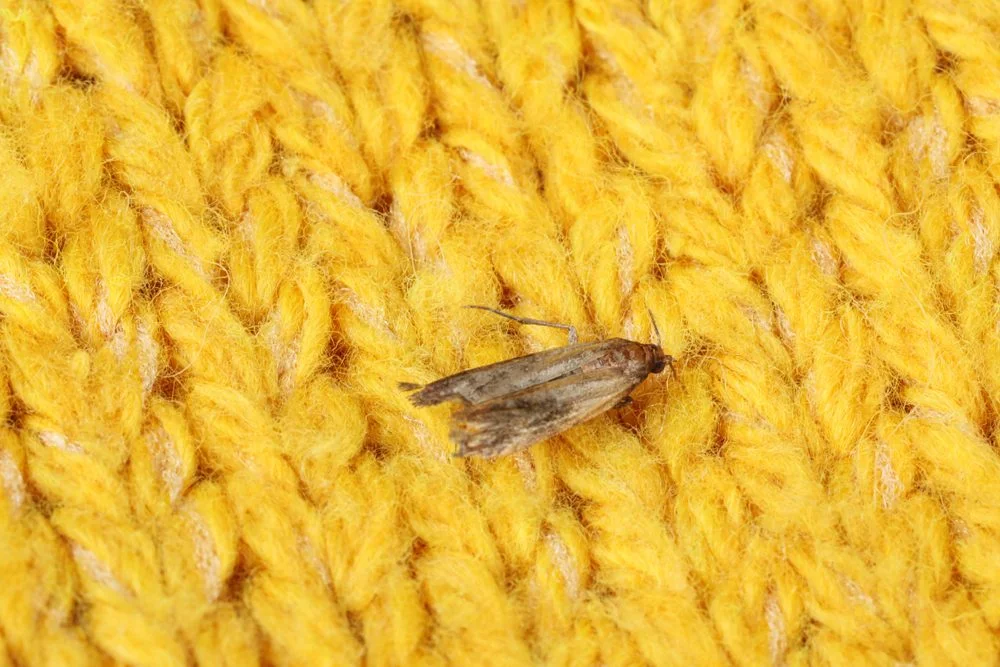Discreet yet formidable, clothing moths take great pleasure in feasting on your wardrobe. You’ve likely experienced that unpleasant moment: pulling out your favorite cashmere sweater only to find it riddled with tiny holes.
Moths don’t just attack your clothes: carpets, curtains, and rugs are also on their menu. So, how can you keep these unwanted pests at bay without resorting to chemical products? Here are 100% natural solutions that have been tested and approved!
How to Identify Clothing Moths
The clothing moth resembles a small brown butterfly with golden highlights, typically measuring between 7 to 10 mm. What do they love? Dark, closed, and poorly ventilated spaces like wardrobes and closets.
These pests feed on natural animal fibers such as wool, silk, leather, and cashmere. They belong to the group of “keratin-eating insects,” which can digest the keratin found in hair and fur.
Their larvae, which are extremely voracious, are the primary culprits behind the damage. An adult moth generally lives for about 15 days but can lay up to 200 eggs during this short timeframe!
Do Not Confuse Clothing and Food Moths
Be careful; clothing moths are not the same as the moths infesting your dry food:
- Food moths are larger (10 to 15 mm) and are whitish-grey in color.
- They feed on cereals, flour, chocolate, and dried fruits.
- They primarily thrive in the kitchen or pantry.
Where Do Moths Come From and Why Are They Here?
Have you ever wondered how these pests found their way into your home? They enter through open windows or doors, seeking warm, quiet places filled with nourishing textiles.
Clothing, especially items that have already been worn, attracts them due to residual body odors. A non-ventilated, tranquil, and slightly heated closet is therefore a paradise for them.
Steps to Get Rid of Moths
If you’ve spotted larvae on your sweaters or in your drawers, follow these steps to naturally eliminate clothing moths:
1. Identify Affected Areas
Look for cocoons, larvae, and tiny insects wherever you store laundry. In wardrobes, closets, wallpapers, or carpets, take the time to meticulously vacuum.
To prevent a new infestation, immediately empty the vacuum’s bin or bag.
2. Clean with White Vinegar
After vacuuming the affected areas, grab a sponge soaked in hot water and organic white vinegar. Thoroughly scrub wardrobes, hanging spaces, and shelves. The moths hate this smell, which will act as a natural repellent.
3. Treat Your Textiles to Eliminate Larvae and Eggs
Here are two effective solutions to permanently get rid of larvae:
- Wash at a high temperature (60°C) followed by thorough ironing.
- Place your delicate textiles in an airtight bag, then freeze for 72 hours before normal washing.
4. Apply a Natural Moth Treatment
To finish off effectively and prevent the return of these pesky moths, opt for natural treatments that are non-toxic to the environment:
- Pheromone traps that lure and trap adult moths.
- Natural repellent sprays made from essential oils.
- Herbal sachets: lavender, thyme, rosemary, or mint to protect your cabinets.
- Cube or flake soap from Aleppo or Marseille placed in your drawers or closets.
Have you ever been troubled by clothing moths at home? What natural solutions have you chosen to address the problem? Feel free to share your favorite moth-repellent tips in the comments below. We would love to hear your thoughts!

